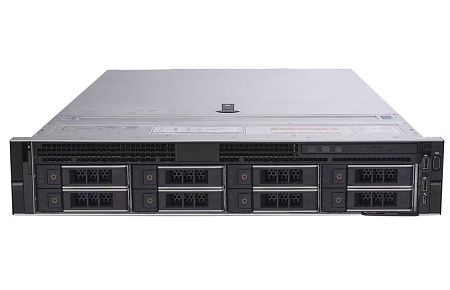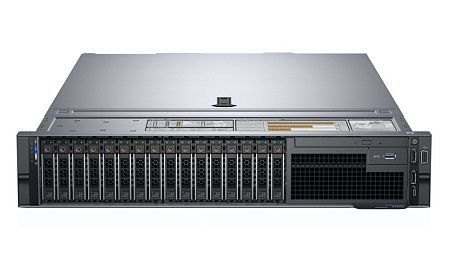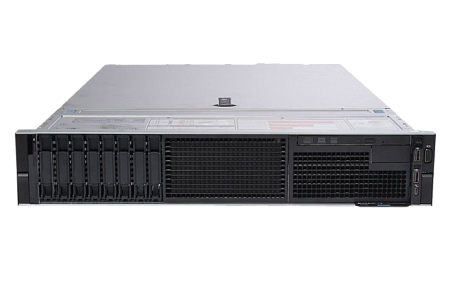Contents of Articles:
- Dell R750 Specifications. Comparison of Dell R750 server with Dell R740
- Dell EMC PowerEdge R750 Architecture and Design
- Dell EMC PowerEdge R750 performance in real tests
- Dell R750 options
- Conclusion
Dell R750 Specifications. Comparison of Dell R750 server with Dell R740

The Dell EMC PowerEdge R750 is a dual-socket rack server in a 2U form factor, making it an ideal choice for enterprise-class environments. It's known for its compact design, which efficiently utilizes rack or closet space. In this discussion of its technical specifications and capabilities, we will also draw comparisons with the Dell R740 server, which we previously reviewed.
|
Parameter |
Dell EMC PowerEdge R750 |
Dell EMC PowerEdge R740 |
|
CPU |
2 x Intel Xeon Scalable 3 (up to 40 cores per processor). |
2 x Intel Xeon Scalable 1 or 2 (up to 28 cores per processor). |
|
Form factor |
2U |
2U |
|
Network |
1 x OCP 3.0 (x8 PCIe). |
Various rNDC options. |
|
Memory |
16 x PMem - Intel Optane Persistent Memory 200 Series (up to 8 TB), 32 x DDR4 RDIMM (up to 2 TB), LRDIMM (up to 8 TB), Up to 3200 MT/s. |
12 x PMem - Intel Optane Apache Pass (up to 6.14 TB or up to 7.68 TB in combination with PMem + LRDIMM), 12 x NVDIMM (up to 192 GB), 24 x DDR4 RDIMM (up to 1.53 TB), LRDIMM (up to 3 TB), Up to 2933 MT/s. |
|
Disk controllers |
HBA355I, HBA355E, H345, H745, H755, H755N, H840, BOSS S1, BOSS S2, SW RAID: S150, HW RAID: PERC 10.5 & 11 (dual PERC Option), HW NVMe RAID. |
HBA330, H330, H730P, H740P, H840, 12G SAS, HBA Mini Mono: HBA330, H330, H730P, H740P, SW RAID: S140. |
|
Drives |
3.5’ LFF, 2.5’ SFF; 12 GB SAS, 6 GB SATA, NVMe (up to 24 pieces) + U.2 form factor. |
3.5’ LFF, 2.5’ SFF; 12 GB SAS, 6 GB SATA, NVMe (up to 24 pieces). |
|
Power supplies |
100~240VAC/240VDC: 800W, 1100W, 1400W, 2400W, DC-48V~-60V: 1100W. |
AC (Platinum): 495W, 750W, 1100W, 1600W, 2000W, 2400W, AC(Titanium): 750W, DC: 1100W, Mix Mode/HVDC: 750W, 1100W. |
|
USB ports |
On the back panel: 2 ports (bottom: USB 3.0, top: USB 2.0), On the front panel: 1 port (USB 2.0), 1 for control via iDRAC Direct (micro-USB), Internal: 1 port (USB 3.0) for IDSDM. |
On the back panel: 2 ports (USB 3.0), On the front panel: 2 ports (USB 2.0), 1 for control via iDRAC Direct (micro-USB), Internal: 1 port (USB 3.0). |
|
PCIe slots |
8 x PCIe 4.0 (up to 6 x16 slots), SNAP I/O. |
8 x PCIe 3.0 (up to 4 x16 slots). |
|
LOM |
2 x 1Gb. |
No. |
|
GPU (internal) |
Up to 6x single width, LP/FH, HL (75W each), Up to 4 x 16 single width, FH, FL (150W each) or 6x8 PCIe single width FH, FL (75W each), Up to 2 x double width, FH, FL (300W each). |
Up to 6 x 75W single width, Up to 3 x 300W double width. |
|
System Management |
QuickSync 2.0, OpenManage, LC 3.x, Digital License Key, OMPC3, iDRAC Direct (dedicated micro-USB port), Easy Restore. |
Digital License Key, OpenManage, LC 3.x, QuickSync 2.0, OMPC3, vFlash, iDRAC Direct (dedicated micro-USB port), Easy Restore. |
|
Capabilities for High Availability |
Hot-swappable power supplies, Hot-swappable fans, Hot-swappable drives, BOSS S1, BOSS S2 hot-swappable, IDSDM. |
Hot-swappable fans, Hot-swappable drives, Hot-swappable power supplies, BOSS, IDSDM. |
According to the table, the internal layout of components in the R750 has become more dense, which led to the possibility to install more RAM sticks.

Cooling system
The cooling system has also been upgraded. The air flows are distributed more evenly in the R750. This reduces the number of “hot spots”.
After modernization (three levels, five blades), the fans became more powerful and reliable.

Moreover, Multi-Vector Cooling (MVC) 2.0 technology was implemented in the R750. The functions of this technology are:
- analysis of air flow temperature at the inlet and outlet,
- processing of received data,
- data transfer to the user for fine-tuning cooling.
This is possible if there is embedded automation, which is triggered when the memory, graphics accelerators, processors themselves, or other components become critically overheated.

Left fan from R740, right fan from R750
For high-density environments there is an option – DLC (Direct Liquid Cooling). The R750 has an embedded leak detection system, which is extremely necessary, since liquid cooling can lead to a short circuit and even a fire. This technology immediately performs the following actions:
- de-energize the system,
- shut off the coolant flow,
- send a notification to the system administrator.
Other changes:
- PCIe 4.0 and upgrade of existing technologies.
- Modern Intel Xeon Scalable 3 processors.
- Improved disk subsystem.
- Increased memory speed.

Dell EMC PowerEdge R750 Architecture and Design
Server design does not change much from one generation to another, since, first of all, all server components have a functional purpose.
However, it is worth noting such an element as the bezel (it is purchased separately). Being an additional design element for the front part of the server, the bezel has certain functionality – using the front bezel you can lock front interfaces, disk cages, etc.

Next, let's consider the architecture. The front panel includes:
- Basic power button.
- USB type A and Micro-USB for control via iDRAC.
- Status indicators responsible for visual identification of emergency situations.
Disk subsystem
R750 provides 4 options for disk baskets on the front:
- Up to 24 2.5" SAS/SATA/NVMe (HDD/SSD) up to 368.84 TB.
- Up to 16 x 2.5" SAS/SATA/NVMe (HDD/SSD) up to 245.76 TB.
- Up to 8 2.5" NVMe (SSD) up to 122.88 TB.
- Up to 12 3.5" SAS/SATA (HDD/SSD) up to 192 TB.

There are also 2 options for the rear compartments:
- Up to 4 x 2.5" SAS/SATA/NVMe (HDD/SSD) 61.44 TB (max.)
- Up to 2 x 2.5" SAS/SATA/NVMe (HDD/SSD) 30.72 TB (max.)

The R750 has one important feature – support for PCIe 4.0 drives and the U.2 form factor. This feature allows you to install modern drives that are characterized by high reading and recording speeds. Example of a possible drive – SSD Intel U.2 D7-P5510 3.84 TB:
- up to 3400 Mb/s recording,
- up to 6500 MB/s reading,
- 170,000 IOPS when recording 4KB files with a queue depth of 32.
R750 has another additional feature – new BOSS-S2 boards with hot plugging (it is provided through a special cassette on the back side). Relevant maintenance is carried out very easily and quickly thanks to this solution.

Scalability and Network
Scalability – availability of 8 PCIe 4.0 slots (six of which are x16), as well as new optional SNAP I/O module. This module divides the x16 slot into two x8. Using the SNAP module, the network card can simultaneously interact with two processors.
Network – 2 embedded Gigabit ports 8P8C and OCP 3.0. Now users have the opportunity to use several ports at once (no need to choose between 2 data speed options).

Dell EMC PowerEdge R750 performance in real tests
We will consider a very powerful platform for testing:
- CPU — 2 x Intel Xeon Scalable (3rd generation). Model 8380;
- Drives — 8 x Intel P5510 3.84TB Gen4 SSD;
- RAM – 32 x 32GB DDR4 3200 MT/s;
- CentOS 8.2;
- ESXi 7.0u1.
SQL Server Efficiency
Each SQL Server virtual machine includes the following components:
- 2 virtual disks –100 GB for boot and 500 GB for database and log files;
- 64 GB of DRAM;
- 16 vCPU;
- LSI Logic SAS SCSI controller.
SQL tests are conducted in order to study the response time.
SQL Server configuration for the test (for each VM):
- Windows Server 2012 R2;
- Storage size: 600 GB allocated, 500 GB occupied;
-
SQL Server 2014:
- DB size: 1500;
- Virtual client loads: 15000;
- RAM buffer: 48 GB;
The test lasts 3 hours:
- 2.5 hours of preliminary preparation;
- 30-minute sample period.
For SQL Server, the considered configuration showed a delay of 1 ms for the entire testing time with eight VMs.

Sysbench MySQL Efficiency
Each Sysbench VM includes the following components:
-
Three virtual disks:
- with pre-embedded database (~447 GB);
- to download (~92 GB);
- for the tested database (270 GB).
- 60 GB of DRAM;
- 16 vCPU;
- LSI Logic SAS SCSI controller.
Sysbench MySQL test is carried out in order to measure:
- average data transfer rate,
- average delay,
- average delay in the 99th percentile (p99-metric).
Sysbench configuration for the test (for each VM):
- Percona XtraDB 5.5.30-rel30.1;
- CentOS 6.3 64-bit;
-
Database tables – 100:
- DB size: 10,000,000,
- RAM buffer: 24 GB,
- Database streams: 32.
The test lasts 3 hours:
- 2 hours of preliminary preparation of 32 streams;
- 1 hour – 32 streams.
TPS indicators
Sysbench OLTP measured a score of 29174 TPS for 8 VMs (1 VM – range from 3631 to 3665 TPS). 16 VMs – 26838 TPS (1 VM – range from 1662 to 1690 TPS).
With increasing loads, performance naturally decreases, since there is an oversaturation point for each platform. However, it is worth noting that the new 8380 Intel Xeon Scalable 3 processors provide a high level of efficiency. They also have a certain reserve.

Average delay:
- The cumulative indicator for 8 VMs is 8.77 ms (each VM is from 8.73 ms to 8.81 ms).
- The cumulative indicator for 16 VMs is 19.1 ms (each VM - from 18.87 ms to 19.24 ms).

In the worst case – the 8VM delay was 15.2 ms, the 16VM delay was 35.4 ms.

Dell R750 options
The Dell R750 server has two branches: Dell R750xa and Dell R750xs. These models are similar to the Dell R750, but have certain distinctive features, as they were originally created to perform other tasks.
The table below shows the results of the comparative analysis:
|
Parameter |
Dell R750 |
Dell R750xa |
Dell R750xs |
|
Appointment |
Analytics, HPC, Databases, traditional corporate IT environments: VDI, AI or ML. |
high-performance computing and virtualization, artificial intelligence, machine learning, logical inference systems. |
Databases, SDS, virtualization, medium-density VM, VDI. |
|
CPU |
2 x Intel Xeon Scalable 3 (up to 270W and 40 cores per processor) + Direct Liquid Cooling supported. |
2 x Intel Xeon Scalable 3 (up to 270W and 40 cores per processor) + Direct Liquid Cooling supported. |
2 x Intel Xeon Scalable 3 (up to 220W and 32 cores per processor). |
|
Memory |
16 x PMem – Intel Optane Persistent Memory 200 Series (up to 8 TB), 32 x DDR4 RDIMM (up to 2 TB), LRDIMM (up to 8 TB), Up to 3200 MT/s. |
16 x PMem – Intel Optane Persistent Memory 200 Series (up to 4 TB), 32 x DDR4 RDIMM (up to 2 TB), LRDIMM (up to 4 TB), Up to 3200 MT/s. |
16 x DDR4 RDIMM (up to 1 TB), Up to 3200 MT/s. |
|
Network |
2 x 1GbE LOM + 1 x OCP 3.0. |
2 x 1GbE LOM + 1 x OCP 3.0. |
2 x 1GbE LOM + 1 x OCP 3.0. |
|
Drives |
Up to 24 x 2.5” SAS/SATA HDD, SSD or NVMe with universal slots, Up to 16 x 2.5” SAS/SATA HDD or SSD + 8 x 2.5” NVMe, Up to 12 x 3.5” SAS/SATA HDD, Up to 4 x rear 2.5” SAS/SATA HDD, SSD or NVMe, Rear BOSS-S2 (2 x M.2) – bootable, Internal: IDSDM or USB. |
Up to 6 x 2.5” Direct Attach NVMe, Up to 8 x 2.5” HW RAID NVMe, Up to 8 x 2.5” SAS/SATA SSD, Mixed configuration: up to 4 x 2.5" SAS/SATA SSD + 4 x 2.5" NVMe, Rear BOSS-S2 (2 x M.2) –bootable, Internal: IDSDM or USB. |
Up to 16 x 2.5” SAS/SATA HDD or SSD, Up to 12 x 3.5" SAS/SATA HDD + 2 x 2.5" rear, Up to 12 x 3.5” SAS/SATA HDD, HW NVMe RAID (8 x 2.5” with PERC H755N), Mixed configuration: up to 16 x 2.5” SAS/SATA HDD or SSD + 8 x NVMe, Rear BOSS-S2 (2 x M.2) – bootable, Internal: IDSDM or USB. |
|
Disk controllers |
HW RAID: PERC 10.5 & 11 (dual PERC Option), HW NVMe RAID, Embedded SW RAID: present. |
HW RAID: PERC 10.5 & 11 (no dual PERC option), HW NVMe RAID, Embedded SW RAID: present. |
HW RAID: PERC 10.5 & 11 (no dual PERC option), HW NVMe RAID, Embedded SW RAID: present. |
|
USB ports |
On the back panel: 2 ports (bottom: USB 3.0, top: USB 2.0), On the front panel: 1 port (USB 2.0), 1 for control via iDRAC Direct (micro-USB), Internal: 1 port (USB 3.0) for IDSDM. |
On the back panel: 2 ports (bottom: USB 3.0, top: USB 2.0), On the front panel: 1 port (USB 2.0), 1 for control via iDRAC Direct (micro-USB), Internal: 1 port (USB 3.0) for IDSDM. |
On the back panel: 2 ports (bottom: USB 3.0, top: USB 2.0), On the front panel: 1 port (USB 2.0), 1 for control via iDRAC Direct (micro-USB), Internal: 1 port (USB 3.0) for IDSDM. |
|
GPU |
6 x 75W SW, 4 x 150W SW, 2 x 300W DW. |
2 x 75W SW, 4 x 150W SW, 4 x 300W DW. |
Not supported. |
|
PCIe slots |
Up to 8 x PCIe Slots Gen4 (up to 6 x16) with SNAP I/O option. |
Up to 8 x PCIe Slots Gen4 (6 x16, 2 x8). |
Up to 5 x PCIe Gen4 (5 x16), 1 x PCIe Gen3 (x8) with SNAP I/O option. |
|
Power supplies |
800W, 1100W, - 48Vdc/1100W,1400W, 2400W. |
1400W, 2400W. |
600W, 800W, 1100W, -48Vdc/1100W 1400W. |
|
Form factor |
H x W x D: 2U x 434mm x 736mm. |
H x W x D: 86.8mm x 434mm x 837.2mm. |
H x W x D: 2U x 434mm x 721mm. |
|
Capabilities for high availability |
3-level hot-swappable fans, hot-swappable discs, power supply, IDSDM and BOSS-S2 (2 x M.2). |
3-level hot-swappable fans, hot-swappable discs, power supply, IDSDM and BOSS-S2 (2 x M.2). |
3-level hot-swappable fans, hot-swappable discs, power supply, IDSDM and BOSS-S2 (2 x M.2). |
|
System management |
iDRAC9 Enterprise, Datacenter license options; OpenManage Enterprise and Plugins (PowerManager, SupportAssist, and Update Manager); iDRAC Direct, Quick Sync 2.0. |
iDRAC9 Enterprise, Datacenter license options; OpenManage Enterprise and Plugins (PowerManager, SupportAssist, and Update Manager); iDRAC Direct, Quick Sync 2.0. |
iDRAC9 Enterprise, Datacenter license options; OpenManage Enterprise and Plugins (PowerManager, SupportAssist, and Update Manager); iDRAC Direct, Quick Sync 2.0. |
Conclusion
Thus, Dell EMC PowerEdge R740 is the most popular and reliable Dell server. They have a very high level of performance, as well as a huge potential. Considering the fact that the R740 still copes well with all necessary tasks, the R750 has been modified and improved in many ways. Great attention was paid to details, which made the R750 more reliable and suitable for a wide range of tasks.







